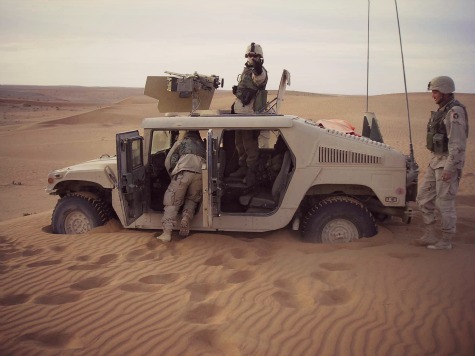When President Barack Obama addressed the nation at West Point in December of 2009, he announced he would be sending 30,000 U.S. troops to Afghanistan as part of a surge in order to “reverse the Taliban’s momentum and deny it the ability to overthrow the government.”
“We will pursue a military strategy that will break the Taliban’s momentum and increase Afghanistan’s capacity over the next 18 months,” Obama said then, laying down markers.
Nearly three years later, Obama’a Afghanistan strategy has failed, resulting in thousands of dead American troops and tens of thousands more maimed. Even the military’s own report card gave the Afghan surge a failing grade in a September 2012 review. The Taliban has been emboldened, waiting for America to fully withdrawal from “combat” after Obama telegraphed America’s plans to the world. In fact, the Taliban is so greatly thriving that Afghan President Hamid Karzai has been forced to try to cut deals with Taliban forces and even consider power-sharing arrangements in some provinces. And even Afghan troops who have been trained by U.S. and coalition forces are now killing Americans in insider attacks. These so-called “green-on-blue” attacks have accounted for nearly 14% of coalition casualties in 2012.
Some more startling facts:
The insurgency launched more attacks this year. In some cases, substantially more: insurgents attacked about 2,000 times in July 2009 and a shade over 3,000 times in July 2012. ISAF registered about 475 attacks from homemade bombs in July 2009; and about 625 in July 2012.
A Washington Times editorial asserted, “the Afghan strategy announced in December 2009 is no longer relevant,” and “the future in Afghanistan is not stability or pacification but all-out civil war.”
“The Afghans know that the Obama administration intends to leave the country as soon as possible and are planning accordingly,” The Times wrote. “The Karzai government, provincial leaders, tribal chiefs and ordinary villagers have to make key decisions about who their friends are, who their enemies are and whether it makes more sense to prepare to fight or seek a separate peace with the Taliban.”
And in a remarkable turn of events, Karzai has even publicly said he would like to see Taliban leader Mullah Mohammad Omar run for office in Afghanistan and can “come inside Afghanistan anywhere he wants to.” Omar is the leader of the group Obama said the surge was intended to take out.
“I repeat my call on all Afghans, those who aren’t the puppets of others and have (only) issues with us at home – they’re welcome for any talks,” Karzai said at a news conference in July. “Mullah Mohammad Omar can come inside Afghanistan anywhere he wants to. He can open political office for himself but he should leave the gun.”
Karzai said Mullah Mohammad Omar, “along with his friends can come and create his political party, do politics, become a candidate himself for the elections. If people voted for him, good for him, he can take the leadership in his hand.”
Les Gelb, the president emeritus of the Council on Foreign Relations, declared, “from the day he took office three years ago, Afghanistan became Obama’s war.”
Gelb noted that since the surge, “casualties and costs skyrocketed” in Afghanistan, and “it was Obama who trumpeted the unachievable goals of defeating the Taliban and ensuring that al Qaeda never returned to Afghan soil to plot another attack on America soil.
“To me, the only way to think about Afghanistan is to ask the question directly and without prejudice: is it in America’s vital interests to fight on in Afghanistan?,” Gelb wrote. “To me, the answer is an unequivocal ‘No.’
There have been more deaths and casualties in Afghanistan under Obama’s first term than in George W. Bush’s two terms. In fact, nearly 70% of the deaths and 80% of all injuries in Afghanistan have occurred under Obama’s watch. American troops have already had to deal with impossible rules of engagement and now there is even more uncertainty about which Afghans are friends and which foes.
Obama has publicly announced U.S. troops would take all combat troops out of Afghanistan by 2014, but he has backtracked on that pronouncement and now it seems like U.S. troops will be in Afghanistan for a considerably longer period of time engaging in more nation-building exercises that are getting the troops slaughtered on daily basis.
And as Wired noted, some U.S. combat troops may still remain in Afghanistan after 2014:
In other words, the gradual process of withdrawing 100,000 troops that begins in July 2011 won’t conclude in 2014. Some unspecified number of U.S. troops will remain in Afghanistan, perhaps even in combat roles supporting Afghan troops if the Afghans get overwhelmed — much like in Iraq.
When then-candidate Obama was campaigning in 2008, he criticized Bush’s successful Iraq surge and said,”now is the time for a responsible redeployment of our combat troops that pushes Iraq’s leaders toward a political solution, rebuilds our military, and refocuses on Afghanistan and our broader security interests.”
“I will make the fight against al Qaeda and the Taliban the top priority that it should be,” Obama said then. “This is a war that we have to win.”
President Obama tried to succeed in Afghanistan like Bush did in Iraq with the surge. Ultimately, what Obama did was send U.S. troops on a nearly impossible mission while handcuffing them with restrictive rules of that has turned Afghanistan into a country where U.S. troops are vulnerable to being slaughtered every day while the Taliban continues to gain strength.

COMMENTS
Please let us know if you're having issues with commenting.